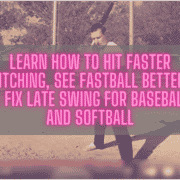Improve Hitting Timing Tips, Get Front Foot Down, & Fix Late Baseball Softball Swing | Josh Hamilton Batting Rhythm Breakdown
Discover how to improve hitting timing tips, get the front foot down on time, and fix late baseball or softball swing. Learn how in this Josh Hamilton batting rhythm swing breakdown.
Josh Hamilton Swing Breakdown: Coaches Don’t Tell You This…
…In this Josh Hamilton swing breakdown we’re focusing on what most coaches don’t tell you (or simply don’t know) about calibrating the timing of a hitter. You can have the best hitting mechanics, but if timing is off, results can be frustrating. In this video, we’ll analyze:
- When does a swing start?
- Leg kick or slide step? and
- How to practice timing?
When Does a Swing Start?
Short answer? About when the hitter picks the front foot up. When walking, you can’t take a step forward without picking up your foot and putting it back down. This is why I hate “no-stride” coaching cues. Here’s how walking bio-mechanics work:
- Front heel hits the ground signals pelvis to open.
- Same timing signal travels up the spine to the shoulders, telling them to counter-rotate the pelvis.
- This is why your opposite arm and leg come forward at the same time.
This simple timing mechanism is important to hitting. Hitting experts call this torque, but really, it’s how humans are designed to move against gravity using the spine for locomotion. CLICK HERE for a more in–depth study on walking bio-mechanics according to Dr. Serge Gracovetsky.
Leg Kick or Slide Step?
It ALL depends on a batter’s moving parts…
- Leg Kick a-la Josh Hamilton forces the hitter to start the swing sooner. Hamilton starts his when the pitcher breaks the hands.
- Slide Step a-la Mike Trout can start their swing later. You’ll see these types of hitters picking their front foot up when the pitcher lands and/or begins forward movement with the arm.
SCIENCE-BASED TRAINING:
Improve your hitting strategy dramatically by applying human movement principles.
Learn not only how and what to train but also the science behind the methods.
How to Practice Timing
SEVEN ways a hitter can practice “collecting data”:
- LIVE arm: whether seated – on a bucket, kneeling, or standing.
- Soft toss or LIVE: throw baseballs, whiffle, dimple, tennis, golf, or dried pinto beans.
- Broad focus: have hitter pick out a point in the pitcher’s delivery to start the swing.
- On-Deck circle: work on when to pick front foot up.
- Sit in on Bullpens: hitter passively (no swings) sits in on pitcher bullpens (with a helmet on of course).
- Pitcher’s BP: have pitchers trade off throwing batting practice (advanced).
- Intra/Inter-squat games.
Above-all, be safe. The truth about Josh Hamilton timing? It takes reps, reps, and more reps. CLICK HERE for Part-3 Matt Holliday: The Death Of Plate Discipline. In case you missed Part-1 Mike Trout: Why Your Consistency Won’t Improve, CLICK HERE.
- Fix Late Swings Fast: 2025 Pitch Recognition & See-Decide-Swing Training for Youth Baseball Power Hitters - October 6, 2025
- Safe Youth Weighted Bat Training: Proven Overload/Underload Drills to Increase Exit Velocity in Games Starting Tonight - September 29, 2025
- AI Coaching Course 2025: Youth Baseball & Softball Practice Plan + Off-Season & In-Season Workout Builder Fast - September 23, 2025













Hey Joey great stuff. You mentioned when the front heel hits the ground it signals the hips to start to open. I would think it would signal the back foot to start rotating which in turn leads to the knee then hips then hands last. Just a thought.
John, I love your thinking!! Yes, you’re correct. It’s why I hate the no-stride coaching cue. It doesn’t allow a hitter to fully engage in this compression signal. You’d love reading the pdf link I posted in the article.
With a no stride swing you can still spike your front heel down. In fact, that’s how a good no stride swing works. As evidenced by Albert Pujols or occasionally Miguel Cabrera.
David O, you’re correct…I call it shifting foot pressure. And that’s how golfers do it. I also promote it more to my fastpitch softball hitters because of the reduced reaction time.